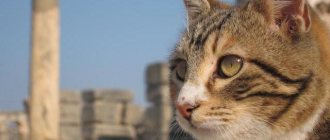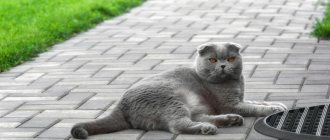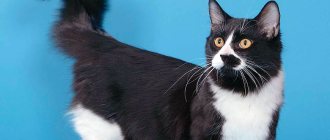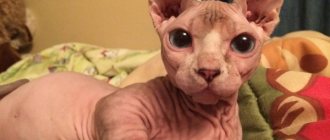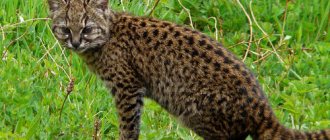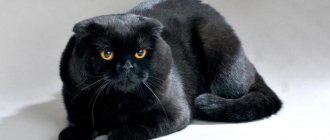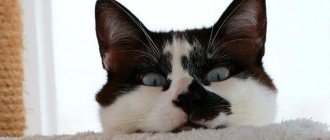Havana Browns are graceful, narrow-faced cats with movable locator ears and fur with a uniform brown tint. Interesting appearance, high intelligence and amazing character make them an object of increased interest among connoisseurs of rare breeds. But before you get a green-eyed beauty in a chocolate fur coat, you should figure out what else is hidden behind the exotic appearance of the Havana Brown.
Brief history of the breed
The Havana Brown breed originated in England. Although the first records of similar cats date back to the 1800s, deliberate selection began in the 1950s. The breeding of the Havana began with the light hand of three breeders - Baroness Miranda von Ullman, Mrs. Fisher and Anne Hargreaves.
To achieve their goal, the women used chocolate and seal point Siamese and black shorthaired domestic cats. At some point, the blood of Russian Blues was added to the mestizos, but its genes are absent from the DNA of modern Havana.
The new breed received official status in 1958. Around the same time, part of the livestock was exported to the United States. Due to problems with genetics, representatives of the English line began to be crossed with cats of other breeds. Because of this, their fur acquired a variety of shades, and they themselves began to be called the chestnut oriental cat. Unlike their British counterparts, American breeders only bred cats with chocolate coats. It was they who received the name “Havana Brown”.
Character
Havana can be awarded first place among intelligent breeds. Every Havana cat seems to be created to be admired and loved. And at the same time, these animals themselves are an example of a friendly and attentive attitude towards their owners.
An important character trait of the Havana is sociability. People play a big role in their lives. Smart, sensitive and tactful, representatives of this breed are affectionate, find an approach to all family members, constantly seek the attention of the owner and need communication, and love games.
It is not advisable to leave them alone for a long time. Attacks of aggression are unusual for pets. They usually get along well with small children or other animals.
Breed description, standards, appearance
The Havana Brown is a graceful cat with well-developed muscles and short hair. Visually, it resembles the Siamese, but differs from them in having green eyes, an elongated narrow muzzle, large ears and a uniform brown color.
Dimensions and weight
The Havana is a medium-sized cat with moderate sexual dimorphism. The average weight of a female is 2.5-4 kg. The weight of a male can reach 5 kg.
Anatomical characteristics
According to the first and only true TICA standard, a Havana Brown cat must meet the following description:
- The head is elongated, with a rounded muzzle, pronounced cheekbones, a prominent profile and a protruding chin.
- The eyes are large, expressive, almond-shaped. The Havana iris is bright green. In kittens under one year of age, the color of the eyes may change.
- The cat's ears are set wide and slightly tilted forward. The shells are large, with rounded tips.
- The body is elegant, slender, with developed muscles, strong bones and minimal fat reserves.
- The limbs are proportional, with developed joints. The front legs are slightly shorter than the hind legs, which is why the Havana's croup appears slightly raised. The paws are compact, with pink pads.
- The tail is long, with a pointed tip.
Color and coat type
The Havana is a short-haired cat breed with smooth, glossy, chocolate-colored fur. The animal's coat may have a red-brown or brown-violet tint. The color of the Havana's whiskers should match the color of the coat. The nose is pigmented brown with a pink tint.
On a note. Havana Brown kittens can have a tabby pattern. But by the age of one year, the spots and stripes on their coat completely disappear.
Possible breed defects
Flaws in appearance, in the presence of which the Havana will be disqualified and classified as a representative of the pet class breed:
- creases and curvatures of the tail;
- spots and medallions;
- polydactyly;
- iris color other than green;
- discrepancy between the shade of the mustache, nose and fur;
- not pink paw pads.
Breed characteristics
At first glance, it may seem that the cat is miniature and very light in weight, but this is not so. An adult cat weighs about five kilograms, on average about 3-4. The Havana Brown is a fairly large cat for its small size.
The International Cat Association provides a detailed description of the Havana genus:
- Cats' heads are much longer than they are wider. Particular attention is drawn to the selection, which has a fairly short coat, and its sophisticated profile attracts with a bend at the bridge of the nose. This breed has a rounded muzzle, but at the same time, expressive cheekbones.
- The ears of the Havana are slightly tilted forward, set wide, huge, with rounded tips and a minimum of fur.
- The eyes are usually green. They are large and oval. It would not be surprising if a month-old Havana has bluish eyes, because their color changes throughout the year from birth.
- The body is of moderate size, quite proportionate.
- The Havana has long and thin legs. The rear ones are a little longer than the front ones.
- The cat's tail is of medium length, tapering towards the tip, but not wide.
Havanas are generally shorthaired. The fur itself is smooth and shiny, a little fluffy, and has a lilac color.
Character and temperament
The Havana Brown is a sociable cat and does not tolerate loneliness well. If an animal is left to its own devices for a long time, it can become depressed and get sick. Unlike many cats, the Havana actively uses its paws. With them she touches objects that interest her and attracts the owner's attention.
The playful and talkative Havana gets along well with children of all ages and gets along well with other pets. She can scratch only through negligence. And if the Havana Brown doesn’t like something, it won’t hiss or release its claws - the cat simply retreats with a loud meow.
Origin story
The breed is the result of crossing Siamese and European Shorthair cats. The brown markings of the Siamese and the careful selection of brown Europeans gave Havana its unique coloration.
The photo of a Havana cat clearly shows how beautiful and unusual the color of its fur is.
How to choose the right kitten
Havana Brown is a rare breed, the bulk of whose livestock is concentrated in the United States and Western Europe. Therefore, it is better to look for a purebred kitten in a foreign cattery.
When choosing a potential pet, you should pay attention to the following nuances:
- availability of pedigree and veterinary passport;
- conditions of detention;
- behavior;
- condition of the kitten's eyes, ears, skin and fur.
On a note. A small kitten may not have a “Cuban” appearance and this must be taken into account when purchasing. Spots and stripes are acceptable on the baby Havana's coat, as well as rings on the tail.
Kitten care
The Havana Brown kitten is ready to go to a new home after it turns 3 months old. Therefore, separating a baby from his mother before this age is not only impractical, but also dangerous for his health. By this time, he manages to receive all the necessary vaccinations, gain basic immunity and learn basic hygiene skills.
Before the kitten arrives, it is advisable to purchase everything you need to care for it:
- bowls for water and food;
- tray with filler;
- bed or house;
- grooming tools (toothbrush, combs, etc.);
- hygienic cosmetics (shampoos, lotions for cleaning ears, etc.);
- toys.
To begin with, the kitten is given several days to adapt and get to know the house. And so that it passes without injury, all potentially dangerous things are removed from the Havana baby in advance: indoor plants, detergents, breakable objects and wires. Close windows and balconies, and also check the insides of ovens and washing machines before turning them on.
The kitten is fed on a schedule that depends on its age. At first, the little Havana is given food 5-6 times a day. Gradually, portions are increased and the number of meals is reduced.
Photo of Havana cat
Read here American Curl - description of the characteristics of the breed, photos and videos of breed standards and price per kitten
Help the site, share with friends 
Care and maintenance
Havana is an unpretentious cat; he does not need specific conditions. To maintain a neat appearance, it requires minimal hygienic care:
- To make a cat's chocolate coat look aesthetically pleasing, it is regularly treated with a special rubber glove. In normal times, the procedure is carried out once a week. During the molting period, the Havana Brown is combed more often. The cat is bathed once every 2-3 months using special shampoos for short-haired breeds that do not dry out the skin and do not cause allergies.
- To remove plaque and prevent dental diseases, the cat's teeth are brushed three times a week with a soft brush and a small amount of non-foaming paste.
- The Havana's claws are trimmed with a nail clipper as they grow. In this case, only the transparent ends are removed.
- The cat's eyes and ears are regularly inspected for any unusual discharge and cleaned with a moistened cotton swab.
Feeding the cat
To maintain health, the Havana Brown needs a nutritious diet with vitamins and microelements. Many modern breeders advise feeding their pets with high-quality premium or super-premium dry food from trusted global manufacturers. This cat food already contains the balance of substances for the normal functioning of the animal’s body, and the owner does not need to independently think through the menu and calculate the proportions.
Havana Brown cats eat the following brands of food quite well:
- Brit Care;
- Farmina;
- Pronature;
- Monge.
Adherents of natural food recommend giving your cat fresh lean meat, cereals, vegetables and fermented milk. It is advisable to include offal, eggs and ocean fish into the Havana Brown's diet twice a week.
Important! Cats of this breed are prohibited from giving fatty meat, river fish, smoked meats, pickles, sausages, sweets, baked goods and any food from the master's table.
Education and physical activity
Havana Browns are moderately temperamental and active cats. They love to climb to high places and watch what is happening from there. Therefore, Havanas need special sports corners with various platforms and ladders on which they can climb and jump.
Cats of this breed are distinguished by a high level of intelligence and good memory. They are easy to train and quickly get used to a certain routine. To train a cat, you just need to communicate with it and give commands in a confident voice.
Character of the breed
Havana needs human interaction. Characteristics of the breed: sociability, affectionateness, friendliness, affability, independence, unobtrusiveness. The cat will not demand attention or interfere with the owner’s household chores, but is constantly nearby and watches the owner’s affairs with interest. The pet also loves to relax with its owner, nestled under the arm.
Havana quickly adapts to the environment, willingly communicates with guests, and enthusiastically participates in children's fun. The main behavioral and character traits are playfulness, talkativeness, and mischief. The pet is ready to play continuously; she received curiosity and a developed hunting instinct from her parents. Havana reacts sensitively to the slightest rustle, does not like closed room doors, knows how to pick up things he likes with his paws, carry them away and hide them so securely that it is useless to look for them.
Loneliness is unbearable for Havana. The pet, having fallen into depression, becomes seriously ill. Therefore, you should not get a cat if you are constantly busy and rarely present at home. To prevent your pet from getting bored, it is recommended to purchase a second cat of a similar breed. Havana gets along well with non-aggressive dogs, but you should not have hamsters and parrots: small animals will be eaten.
Havana is talkative and accompanies every event with meows. The cat's voice is quiet, melodic, similar to a purr, and does not irritate.
Havanas love to climb high and climb wall shelves and cabinets. Therefore, the owner has to constantly ensure that the pet does not break a vase standing on a shelf or tear up the curtains. The cat likes to watch what is happening in the apartment from above and chooses a certain point as an observation point.
Vaccinations and antiparasitic treatment
To prevent infectious and viral diseases, Havana Browns are regularly vaccinated. The first vaccination against calcivirosis, rhinotracheitis and panleukopenia is given to a kitten at the age of 7-8 weeks.
After 28 days, the baby is vaccinated against the same diseases and against rabies. In the future, Havana Brown is vaccinated once a year.
Twice a year, a cat of this breed is given anthelmintic drugs. The dose of the drug is calculated taking into account the body weight of the animal. To combat fleas, special shampoos, drops and anti-parasitic collars are used.
Health and care
Havana cats have a relatively long life expectancy, the average lifespan is about 15 years, but they should be vaccinated on time and periodically visit the veterinarian for examination. In order for the animal's health to be at a high level, one should not forget about the proper nutrition of this breed, feed only high-quality food twice a day, if a kitten - then three times.
Do not forget also about the hygiene of the animal, in order to avoid all kinds of diseases, bathe regularly (wipe dry after washing), comb, clean the ears and teeth. You also need to remember about the character of your pet. Under no circumstances should you leave the Havana alone for a long time - this can cause depression and even illness in your cat.
Pros and cons of the breed
By analogy with cats of other breeds, the Havana Brown has both advantages and disadvantages:
| pros | Minuses |
| Interesting exterior | Intolerance of loneliness |
| Low maintenance | Rarity of the breed |
| High intelligence |
Havana Brown is a beautiful cat with a sophisticated appearance, a rare chocolate color and a good-natured, sociable disposition. She easily makes contact with people and will be an excellent companion to someone who surrounds her with attention and care.
What else you should know about soft tiles:
- When exposed to sunlight, soft roofing naturally sinteres. This way the roofing covering becomes monolithic, providing reliable protection against leaks even in the most complex roof components.
- The basis for the soft roof is fiberglass, which is filled with first-class bitumen on both sides. The outer side of the shingles is treated with stone coating, which gives the roof its final color. A self-adhesive layer is applied to the reverse side, which is protected with plastic film.
- Flexible roofing is available in small shingles of various shapes.
- Today, the range of soft roofs is constantly increasing, and new varieties are being produced. For example, multilayer flexible roofs have appeared that have a guarantee of at least 50 years.
